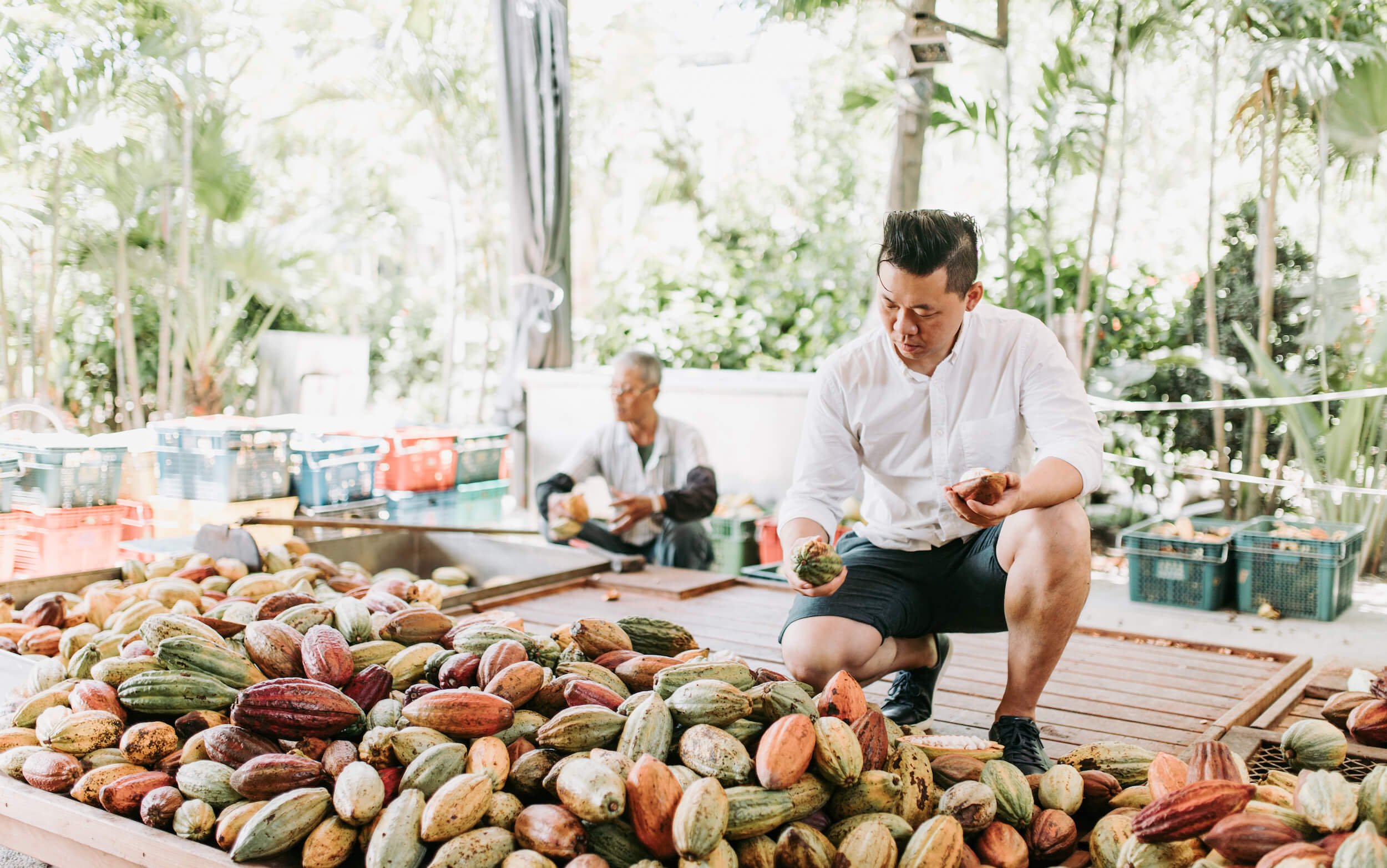The Unique Techniques of Taiwan's Leading Bean to Bar Producer Fu Wan Chocolate
Chocolate production is still a novelty in Taiwan. Although the island flirted with cacao in the 1920s, it wasn’t until the 2000s that its farmers began to gamble with larger plantations. Even now, the cacao they grow—around 250 tons of cacao pods in 2019—is just over one tenth of a percent of that grown by Asia’s largest producer, Indonesia.
Warren Hsu of Fu Wan Chocolate with cacoa pods. Photo courtesy of Warren Hsu Fu Wan Chocolate.
That relative scarcity combined with a typhoon-kissed terroir that produces a milder bean than tropical regions are only part of what makes Taiwan’s leading chocolatier Fu Wan, so distinctive. Its founder and CEO Warren Hsu, a trained chef and the island’s first certified International Institute of Chocolate & Cacao taster is responsible for the rest.
Since launching in 2014, the artisan bean-to-bar brand has beguiled not just the island, but the world. Hsu’s unique process of fermentation, drying, aging and flavoring has helped to earn Fu Wan Chocolate more than 100 International Chocolate Awards in less than a decade. “We’re not selling chocolate. We are creating a new culinary culture,” he explains.
Fermenting cacao. Photo courtesy of Warren Hsu_Fu Wan Chocolate
Chocolate from Bean to Bar
Most of the cacao for Fu Wan’s chocolate, about 20 tons worth of beans from hybrid cacao varietals, comes from family farms within 25 miles of the company’s southern Pingtung factory. The rest, beans from around 300 trees, are grown on the island estate, which also houses a hotel and villas, a tasting room, and a chocolate “museum.”
In Taiwan, cacao is commonly fermented in inexpensive, easy-to-find wooden buckets with slatted bottoms used for steaming rice. It’s a technique Hsu uses at Fu Wan, too, along with fermenting some batches in stainless steel. Small pieces of banana leaf mixed with each 50 lb vat of beans speed the breakdown of enzymes and help to develop flavor and aroma. The banana leaf also affects the flavor of the chocolate, says Hsu.
“We have tried banana leaf from different areas and [the fermented beans] come out with different flavors. Once I substituted bamboo because it has lots of yeast but it turns out it doesn’t taste like chocolate, it tastes like meat,” he laughs. Once fermented, the beans spend eight to ten days drying before being vacuum-packed into plastic bags and aged. The longer they are left, the rounder and more complex the flavor and aroma, says Hsu. From there the beans are roasted in a convection oven, winnowed, and ground. The seasoning, smoking and scenting that follows is where the former chef’s talent shines brightest. He tops bars with traditional island flavors like peppercorns, tea, and lychee and smokes them with herbs and spices like a cinnamon leaf. “One of my most notorious chocolates is made with shrimp and almond,” he laughs.
Over the pandemic, Hsu’s also experimented more with scenting, infusing the chocolate with the aroma of fruit or flowers. “Because most of the flower’s aroma is water-soluble, it’s very easy to get away,” Hsu says. “So [I learned] how to catch it. Now we can handle the aroma of many flowers and put it in the chocolate.”
Fu Wan Chocolate chocolate bars. Photo courtesy of Warren Hsu, Fu Wan Chocolate
A Growing Market for Taiwanese Chocolate
With its attention to local ingredients from bean to bar, Fu Wan Chocolate doesn’t come cheap. The fair-trade cacao at the brand’s core is the most expensive in the world. But despite being three times the cost of similar brands, and despite having virtually no chocolate tradition, the people of Taiwan have fallen for the confection.
“Taiwanese people love the culture and the food from abroad because we are an island,” explains Hsu. “The people on an island take culture from outside very easily.” Luxury brands both on the island and in nearby Japan, too, have taken note: Fu Wan collaborates regularly with major hotels, Michelin starred restaurants, even with fashion designers, to create one-of-a-kind chocolate treats that exemplify their opulent identities.
Outside of East Asia, Fu Wan Chocolate is not yet found with frequency or ease. Just exporting bars to Hong Kong, the company’s biggest market outside of Taipei, is a three day journey across the East China Sea. But Hsu expects the company’s reach to continue to grow as consumers in the European Union, North America and elsewhere increasingly trade mass-produced chocolate for artisanal, bean-to-bar brands. With fermentation techniques drawn from the local vernacular and flavors that capture the terroir and agricultural bounty of the island, Fu Wan is poised to leave its unique mark on the chocolate world. “Chocolate, it’s a kind of language,” says Hsu. “You can communicate with all the people in the world with chocolate.”



